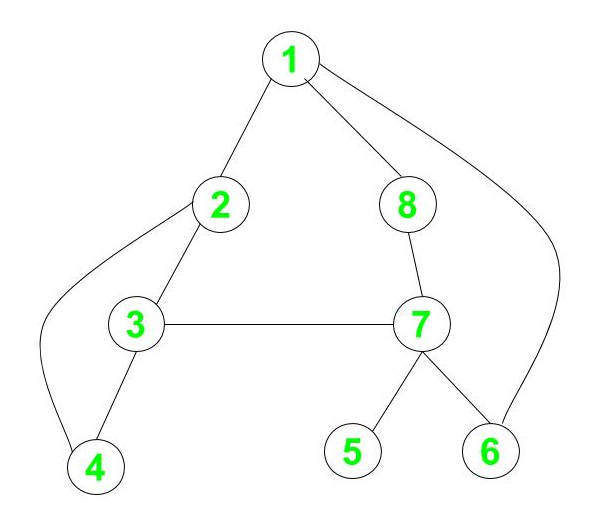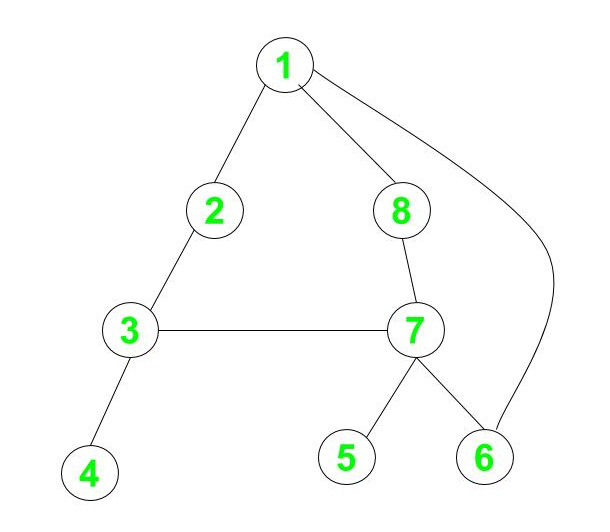给定一个无向图G ,具有V个顶点和E 条边,任务是检查该图是否是 2 边连通的。
A graph is said to be 2-edge connected if, on removing any edge of the graph, it still remains connected, i.e. it contains no Bridges.
例子:
Input: V = 8, E = 10

Output: Yes
Explanation:
Given any vertex in the graph, we can reach any other vertex in the graph. Moreover, removing any edge from the graph does not affect its connectivity. So, the graph is said to be 2-edge connected.
Input: V = 8, E = 9

Output: No
Explanation:
On removal of the edge between vertex 3 and vertex 4, the graph is not connected anymore. So, the graph is not 2-edge connected.
朴素的方法:朴素的方法是在删除任何边X时检查剩余的图G – X是否连接。如果图在一条一条地移除每条边时保持连通,那么它是一个 2 边连通图。为了实现上述想法,删除边并从任何顶点执行深度优先搜索(DFS)或广度优先搜索(BFS)并检查是否所有顶点都被覆盖。对所有E边重复此过程。如果任何边都不能遍历所有顶点,则打印No 。否则,打印Yes 。
时间复杂度: O(E * ( V + E))
辅助空间: O(1)
高效的方法:由于给定的图是无向图,因此只能通过计算连接到节点的边数来解决问题。如果对于任何节点,连接到它的边数为 1,则意味着在删除此边时,该节点将断开连接,并且无法从任何其他节点到达。因此,该图不是 2 边连通的。以下是步骤:
- 创建一个大小为V的数组noOfEdges[] ,它将存储连接到节点的边数。
- 对于每条边(u, v)增加节点u和v的边数。
- 现在迭代数组noOfEdges[]并检查是否有任何边只有 1 个边连接到它。如果是,则该图不是 2-edge connected 。
- 否则,该图是 2 边连通的。
下面是上述方法的实现:
C++14
// C++14 program for the above approach
#include
using namespace std;
// Definition of a graph
class Graph {
// No. of vertices
int V;
// To create adjacency list
list* adj;
public:
// Constructor
Graph(int V);
// Function to add an edge to graph
void addEdge(int v, int w);
// Function to check 2-edge
// 2-edge connectivity
void twoEdge(int v);
};
// Initialize the graph
Graph::Graph(int V)
{
this->V = V;
adj = new list[V];
}
// Adding edges to adjacency list
void Graph::addEdge(int v, int w)
{
adj[v - 1].push_back(w - 1);
adj[w - 1].push_back(v - 1);
}
// Function to find if the graph is
// 2 edge connected or not
void Graph::twoEdge(int v)
{
// To store number of edges for
// each node
int noOfEdges[v];
for (int i = 0; i < v; i++) {
noOfEdges[i] = adj[i].size();
}
bool flag = true;
// Check the number of edges
// connected to each node
for (int i = 0; i < v; i++) {
if (noOfEdges[i] < 2) {
flag = false;
break;
}
}
// Print the result
if (flag)
cout << "Yes";
else
cout << "No";
}
// Driver Code
int main()
{
// Number of nodes and edges
int V = 8;
int E = 10;
// Given Edges
int edges[E][2] = { { 1, 2 }, { 1, 8 }, { 1, 6 },
{ 2, 3 }, { 2, 4 }, { 3, 7 },
{ 3, 4 }, { 7, 5 }, { 7, 6 },
{ 7, 8 } };
// Initialize the graph
Graph g(V);
// Adding the edges to graph
for (int i = 0; i < E; i++) {
g.addEdge(edges[i][0], edges[i][1]);
}
// Function call
g.twoEdge(V);
return 0;
} Java
// Java program for the above approach
import java.util.*;
class Graph{
// No. of vertices
private int V;
// Array of lists for Adjacency
// List Representation
private LinkedList adj[];
// Constructor
@SuppressWarnings("unchecked")
Graph(int v)
{
V = v;
adj = new LinkedList[v];
for(int i = 0; i < v; ++i)
adj[i] = new LinkedList();
}
// Function to add an edge into the graph
void addEdge(int v, int w)
{
adj[v - 1].add(w - 1); // Add w to v's list.
adj[w - 1].add(v - 1);
}
// Function to find if the graph is
// 2 edge connected or not
void twoEdge(int v)
{
// To store number of edges for
// each node
int[] noOfEdges = new int[v];
for(int i = 0; i < v; i++)
{
noOfEdges[i] = adj[i].size();
}
boolean flag = true;
// Check the number of edges
// connected to each node
for(int i = 0; i < v; i++)
{
if (noOfEdges[i] < 2)
{
flag = false;
break;
}
}
// Print the result
if (flag)
System.out.print("Yes");
else
System.out.print("No");
}
// Driver code
public static void main (String[] args)
{
// Number of nodes and edges
int V = 8;
int E = 10;
// Given Edges
int edges[][] = { { 1, 2 }, { 1, 8 },
{ 1, 6 }, { 2, 3 },
{ 2, 4 }, { 3, 7 },
{ 3, 4 }, { 7, 5 },
{ 7, 6 }, { 7, 8 } };
Graph g = new Graph(V);
// Adding the edges to graph
for(int i = 0; i < E; i++)
{
g.addEdge(edges[i][0], edges[i][1]);
}
// Function call
g.twoEdge(V);
}
}
// This code is contributed by offbeat Python3
# Python3 program for the above approach
# Definition of a graph
class Graph:
# No. of vertices
V = 0
# Array of lists for Adjacency
# List Representation
adj = [[]]
# Constructor
def __init__(self, v):
self.V = v
self.adj = [[] for i in range(v)]
# Function to add an edge into the graph
def addEdge(self, v, w):
self.adj[v - 1].append(w - 1)
# Add w to v's list.
self.adj[w - 1].append(v - 1)
# Function to find if the graph is
# 2 edge connected or not
def twoEdge(self, v):
# To store number of edges for
# each node
noOfEdges = [len(self.adj[i]) for i in range(v)]
flag = True
# Check the number of edges
# connected to each node
for i in range(v):
if (noOfEdges[i] < 2):
flag = False
break
# Print the result
if (flag):
print("Yes")
else:
print("No")
# Driver code
if __name__=="__main__":
# Number of nodes and edges
V = 8
E = 10
# Given Edges
edges = [ [ 1, 2 ], [ 1, 8 ],
[ 1, 6 ], [ 2, 3 ],
[ 2, 4 ], [ 3, 7 ],
[ 3, 4 ], [ 7, 5 ],
[ 7, 6 ], [ 7, 8 ] ]
g = Graph(V)
# Adding the edges to graph
for i in range(E):
g.addEdge(edges[i][0],
edges[i][1])
# Function call
g.twoEdge(V)
# This code is contributed by rutvik_56C#
// C# program for the above approach
using System;
using System.Collections.Generic;
class Graph{
// No. of vertices
private int V;
// Array of lists for Adjacency
// List Representation
private List []adj;
// Constructor
Graph(int v)
{
V = v;
adj = new List[v];
for(int i = 0; i < v; ++i)
adj[i] = new List();
}
// Function to add an edge into the graph
void addEdge(int v, int w)
{
// Add w to v's list.
adj[v - 1].Add(w - 1);
adj[w - 1].Add(v - 1);
}
// Function to find if the graph is
// 2 edge connected or not
void twoEdge(int v)
{
// To store number of edges for
// each node
int[] noOfEdges = new int[v];
for(int i = 0; i < v; i++)
{
noOfEdges[i] = adj[i].Count;
}
bool flag = true;
// Check the number of edges
// connected to each node
for(int i = 0; i < v; i++)
{
if (noOfEdges[i] < 2)
{
flag = false;
break;
}
}
// Print the result
if (flag)
Console.Write("Yes");
else
Console.Write("No");
}
// Driver code
public static void Main(String[] args)
{
// Number of nodes and edges
int V = 8;
int E = 10;
// Given Edges
int [,]edges = { { 1, 2 }, { 1, 8 },
{ 1, 6 }, { 2, 3 },
{ 2, 4 }, { 3, 7 },
{ 3, 4 }, { 7, 5 },
{ 7, 6 }, { 7, 8 } };
Graph g = new Graph(V);
// Adding the edges to graph
for(int i = 0; i < E; i++)
{
g.addEdge(edges[i, 0], edges[i, 1]);
}
// Function call
g.twoEdge(V);
}
}
// This code is contributed by Amit Katiyar Javascript
No时间复杂度: O(V + E)
辅助空间: O(V)
如果您希望与专家一起参加现场课程,请参阅DSA 现场工作专业课程和学生竞争性编程现场课程。